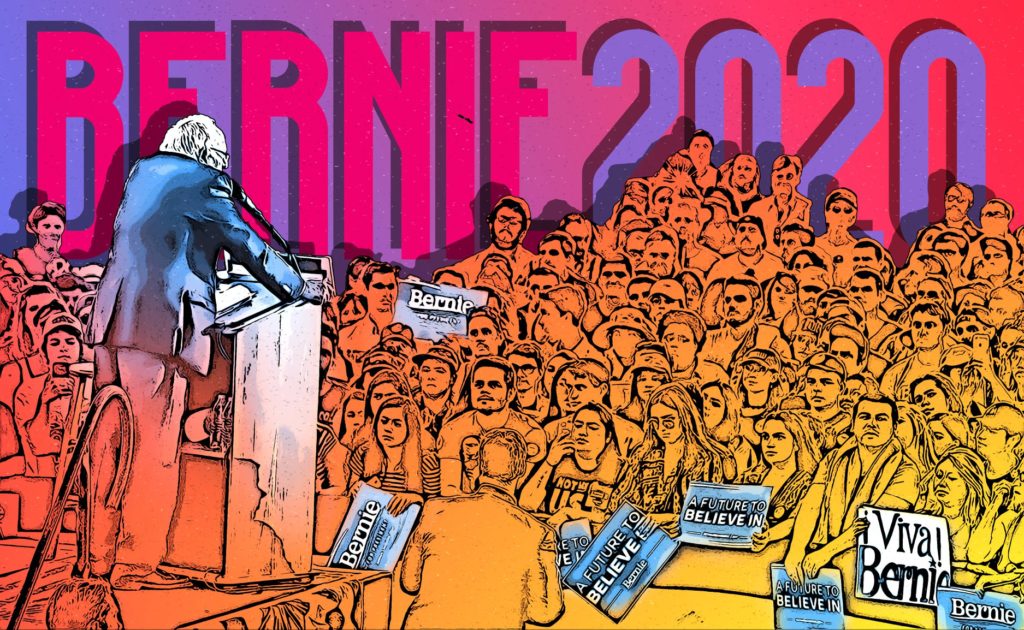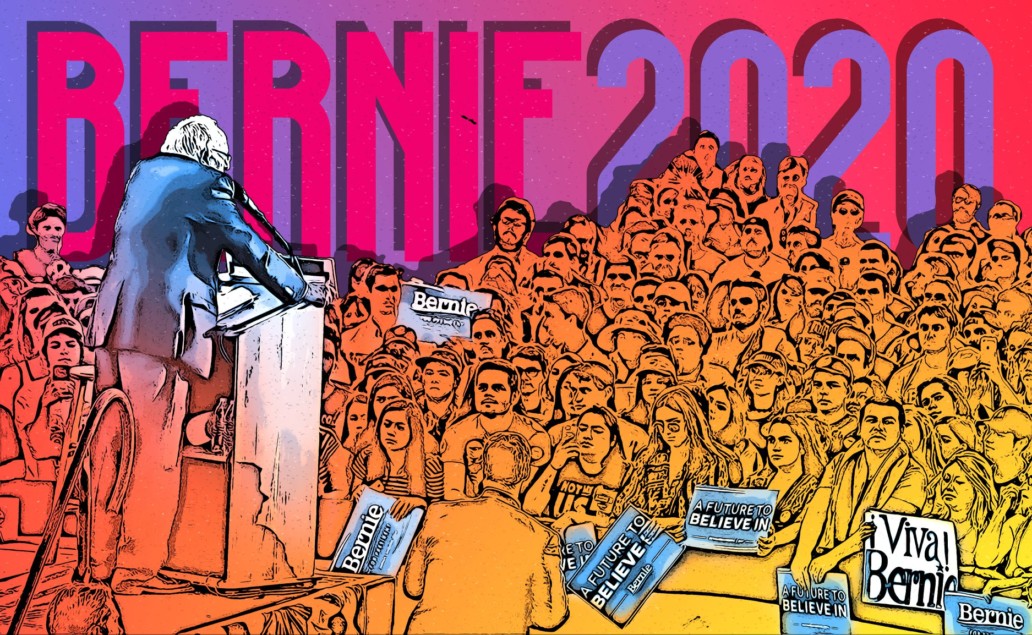I recently wrote about how newly registered voters in California are, in overwhelming numbers, deferring party registration. Astute political friends pointed out that California’s new “motor voter” registration at the DMV defaults to “No Party Preference”if a party isn’t selected and it’s no big surprise that while the Democrats are doing much better than Republicans, most people aren’t too jazzed about picking a political party.
In October, 4,725,054 Californians were Republicans, 5,419,607 NPP, and 8,557,427 were Democrats. The total lead in Democratic registrations, often cited against Republicans, hides a much more significant trend in voter attitude. In the five months between reports, the Democrats added 119,159 new voters, growth of 1.4%. NPP registrations, however, grew 8.35 times as fast and for every new Democrat, five Californians went independent — more than half a million.
Behind these stunning growth numbers is a real opportunity for the “inside / outside” Bernie Sanders campaign. The fastest-growing group of voters in California isn’t happy with the political parties and needs a new message. And with California’s semi-open primary, these NPP independent voters - many of whom are registered for mail ballots in California’s increasingly postal voting-centric system - will simply have to return a postcard requesting a partisan primary ballot. The California Democratic Party has traditionally supported this practice, and even with establishment animosity towards Sanders in place, a huge influx of Berners in recent party elections bodes well for the mixed primary and enlarging the pool of Democratic Party voters, regardless of whether they’ve registered with the party.

I’ve been surprised, however, that Sanders supporters are missing the opportunity to educate and organize these party-free voters, who historically have turned out at much lower numbers than Republican voters. Instead of an education campaign, daily I see Berners on social media urging independent voters to re-register. This strategy simple does not reflect what is happening in our state. Motor voter is bringing new voters in, and if they can’t be convinced to support Sanders and request a crossover ballot, what evidence is there that they can be convinced to re-register to support Sanders?
As I look at 2020 and California’s early primary, this education and follow-up campaign is one of the top opportunities for Sanders’ movement candidacy. Others include using Facebook engagement advertising to activate younger and infrequent voters, and, using consumer data appends to identify likely unregistered, eligible voters and then organizing registration drives.
Aside from the issue of surging NPP registration, there remains the problem of California voters registering as American Independents in confusion. This right-wing party won’t have Democratic crossover ability and groups that want to reach these voters should consider engaging, educational ads targeted at voter file- and append-based custom audiences. We must also support AB 681, a bill by Assemblywoman Lorena Gonzalez (D-San Diego), which will increase the number of notices to voters about their registration and how to request a crossover ballot.
“We just want to make sure people understand that they have to make an affirmative step in order to vote in a presidential primary if they’re not registered as a partisan voter,” Gonzalez told the Los Angeles Times. “The different forms of communication can help if a voter misses one of them.”
What Do We Do with All These Voters (or, Problems We Want to Have!)
There are two relevant facts about the 2018 midterms that should guide the strategic choices of future campaign organizations. First, MORE PEOPLE voted. This election’s turnout, a high for midterms, is only slightly lower than 2016’s 56 percent turnout in a presidential election year. And it’s not just that more people voted. It’s also that they voted proactively, casting early ballots like gangbusters. By November 1, for example, more Texans had cast early ballots than the entire number of Texans who voted in the 2014 midterms. More than 800,000 new voters nationwide registered on National Voter Registration Day alone, a stunning number especially when we consider that Donald Trump is only president because of fewer than 80,000 voters in three states.
Second, NEW DEMOGRAPHICS voted. Nearly as many Latinos voted in the 2018 midterms as the their share in the total eligible voter population. Tons and tons of young people voted. Increasingly, these diverse voting groups are moving towards progressive candidates. The 18-to-29 year-olds who voted in record numbers did so for Democratic candidates rather than Republican ones by a 2-1 margin in 2018. The youth surge translated into a 144 percent increase in youth early voting in Illinois. Democrats enjoyed more than a 2-1 advantage among Latinos, with 69% of voting for Democrats and 29% for Republicans.
The progressive shift is interesting on its own terms, and interesting for campaign data management services because it feels like many of these candidates were younger, with a younger support base, than in previous years, and that youth means smart campaigns will use data management, acquisition, and appending not just to get names of people to send donation requests from, but to create actual spaces for campaign activism.
Accurate Append’s demographic database allows campaigns to collect voter attributes like age, income level, and the very important category of political interests. With that information, campaigns can identify potential volunteers—not just by geographic area (which is really important; people are more likely to volunteer if events are close to home) but also by these other demographics. The database is then verifiable via Accurate Append’s mechanisms of verifying contact data and filling in gaps in contact info.
All of this can be done very quickly, with low turnaround time between the campaign team uploading files of incomplete information and Accurate Append returning the same folder, full of complete info. That quick data management thus not only frees up your time to do better volunteer management, but allows you to target better potential volunteers. In time, that success will feed on itself.
How important is that base of grassroots volunteers? Given the new demographics and higher turnout, it’s more important than ever. One of the many reasons Alexandria Ocasio-Cortez was able to upset Joe Crowley, a virtual shoo-in leader of the mainstream Democratic Party, in their House district primary, was that she cultivated a DIY, “do it yourself” aesthetic in her campaign. That raw look of goodness is made possible by having a good base of volunteers, an advantage Ocasio-Cortez has pointed out more than once herself.
The result was the most successful campaign ad of 2018, and of course, a trip to the U.S. House for the youngest representative in history. And the grassroots “look” wasn’t just a look for AOC’s campaign either. When you’re outspent 18-1 and outraised 10-1 by your machine-tied opponent, you need to make your story resonate with most voters in your district. The ad was written by Ocasio-Cortez and produced by volunteers—and was also populated by volunteers. Although it’s not always glamorous to contemplate, such team efforts are sustained by data, and a good append service is vital to that process.
Beyond just the need to assemble volunteers, this huge upsurge in voter participation and registration means you’re going to need to process, correct, and complete your databases faster. All those new voters are going to need to answer surveys, for example, one of Accurate Append’s proactive strategy services. Segmentation, which the Obama campaign did amazing things with in 2012, will also be a valuable service to apply to new rolls of voter data. Segmentation allows campaigns, if they care to use it, the ability to subsequently deliver different messages depending on voters’ respective levels of support.
The bottom line is that millions of new voters will populate our clients’ communities. The only question is what to do with them, and the only alternative to getting data on them and engaging them is to not gather that data, not engage. And we all know that’s not really an alternative. Races --both primary and general-- are going to become more competitive as progressive candidates start to move against traditionally conservative or center-left districts and officials. Having accurate appended data makes it easier for your campaign to figure out the right moves in those races.
Other Campaign Media Don’t Trade Off with Email - and Won’t Replace It Anytime Soon
Two declarations I hear a lot from political activists who aren’t really familiar with the ins and outs of digital campaigning: (1) email soliciting is impersonal, dehumanizing, and alienating; and (2) email is a flash-in-the-pan campaign medium that’s on its way out.
The first assertion is kind of subjective, I guess, and very situational. I’ve seen crappy email asks. Some of them are hyperbolic (Trump will DESTROY US ALL!!!), while others definitely look like they’ve been written by a bad content generator. But a lot of the emails I see, particularly those associated with good candidates running thoughtful, deliberative campaigns, are things of beauty. They raise important questions, offer honest explanations of voters’ concerns, and sometimes even take the time to explain that policymaking is complex and needs public effort. You can do all that in an email because it’s written and, as I’ll explain below, emails can incorporate other media to help explain or draw attention to particular points.
The second assertion is probably just a reflection of tech writers’ tendency to make declarative statements about what’s in and out, the next big thing, and so on. My friend Colin Delany's recent provocatively titled post “Will Viral Videos Replace Fundraising Email?” is in that spirit. Colin points out that Alexandria Ocasio-Cortez and other successful left Democrats are using viral videos in place of expensive advertising. Videos feel authentic and grassroots, and take advantage of social media conduits to maximize exposure.
Colin doesn’t really answer the question asked in the title of the post, though, other than to acknowledge that email is still necessary as a fundraising platform. I just think it’s a lot more than that. Email won’t be going anywhere any time soon because email is the great synthesizer of media. A well-designed email may be one of the most effective means of disseminating that amazing viral video, or a whole series of videos. It may also contain information about online and live events, or share news articles and pictures. The email’s words help readers understand the significance of the videos and other media, and encourage sharing of them.

Email is also here to stay, at least for now, because emailing provides the means to organize a political community. This is where campaigners can accomplish a lot by creating email surveys when creating constituent communities, utilizing services like email appends and lead validation enhancement, and using tools like Action Network and VoterCircle to organize actions for the communities you’re putting together.
Finally, email allows you to shape the overall argument that incorporates and synthesizes the video or other artifacts. This is a simple truth that’s easy to miss: There’s a difference between writing good emails and mediocre ones. You should find the people on your team who can write good ones, and others should learn from them.
The fact that most recipients don’t open an email and that a tiny percentage may proactively reject it doesn’t really negate any of this. People tune out during political ads on traditional media. They turn the page if they see a political ad in print. That doesn’t mean the ads aren’t effective for those who do pay attention—and in the case of emails, that effectiveness results not only in a reliable donation base, but also the formation of communities centered around, and inspired by (among other things) the words and information in the messages.
What slows down or gums up email campaigning’s potential are really functional issues, not problems intrinsic to the format. Those problems include:
(1) inaccurate information: hastily-assembled or poached email lists can be really outdated, or the lists might not have been vetted.
(2) slowness or bottlenecks in growing your lists: campaign workers may be gathering new sets of names and contact info, but they aren’t getting integrated into the email lists quickly enough to be included in the next regular send. For this, the solution can be as simple as a Google spreadsheet connected to your campaign database via Zapier.
(3) failure to take advantage of common attribute clusters: sometimes you want to separate heavy-responders from those who have never responded; other times you want to hit particular neighborhoods to inform them of a local event, and so on.
(4) failure to be careful about sending emails to unwilling recipients: I’ve seen this happen more often than it should—a campaign casts too wide a net with its initial emails and the next thing you know, they’re dealing with a critical level of spam complaints, which can really slow down campaign logistics.
Services like Accurate Append, voter files and enrichments, and proactive strategies like surveys, can solve these problems. Accurate Append is simply indispensable in updating your files by integrating and supplementing the information from current, valid contact lists. Surveys about issues in the district have, for me, produced open rates of over 20%, and I include a prominent “leave this list” link so that people know there’s no ambiguity there. From there, you can create target lists based on demographics from voter files, turnout history, or other factors.
Emails are here to stay for now: they literally allow you to write out your campaign message, which in turn allows you to facilitate and exploit other media linked to or embedded in the emails, and then pick your own recipients. Rather than fearing or loathing them, teach your campaign teams to write good emails that don’t insult readers’ intelligence, and that take full advantage of viral videos and other dynamic media.
Accurate Append Leads with Rock-Solid Data Practice
Accurate Append is that special kind of tech company that bridges cutting-edge practices and traditional brick-and-mortar businesses. You’d go to them if you need to merge and enhance complicated contact data sets, or if you need to deliver a few thousand postcards for your automotive business. We sat down with Accurate Append’s President Chris Nichols to learn about best practices and changes in the contact data industry.
AHG: What are some of the more complicated challenges you deal with in your business?
 Nichols: In the U.S., contact data for reaching consumers is highly commodified - that means specialty businesses like mine need to differentiate ourselves and offer better quality data. We’ve invested heavily in the last few years in developing algorithms that ensure our customers get the best customer matches, with the most timely information. Sometimes this means merging our proprietary data with client data and filling in the gaps with partner resources - and doing it with very large datasets. That’s a lot of moving parts, and doing it right is a big deal - not just for us, but for our clients’ bottom line.
Nichols: In the U.S., contact data for reaching consumers is highly commodified - that means specialty businesses like mine need to differentiate ourselves and offer better quality data. We’ve invested heavily in the last few years in developing algorithms that ensure our customers get the best customer matches, with the most timely information. Sometimes this means merging our proprietary data with client data and filling in the gaps with partner resources - and doing it with very large datasets. That’s a lot of moving parts, and doing it right is a big deal - not just for us, but for our clients’ bottom line.
AHG: What kinds of things are your customers looking for?
Nichols: One of our newest products for self-serve users is an API for verifying contact data - like, when someone enters an email address on your website, our API will ping back the status of that email. Is it valid? We also offer traditional email append, phone append, and address append services. Many customers just want to make sure their outbound marketing - calls, postcards - is efficient and effective. No one likes calling the wrong person or having their mailers bounce back. We’ve also done quite a lot of work with political campaigns looking to update and verify information on public voter files, where contact information can be quite old.
AHG: What are the technical skill a client must have in order to work with Accurate Append?
Nichols: From none to a whole lot! If you’re just looking to verify whether emails are valid, for example, you can email an attachment to customer service. Then there are what we call “batch” clients who regularly give us large files. This could be a political campaign looking to make sure they are differentiating between cell and landline telephones for compliance and accuracy. For batch customers, we offer FTP processing. You upload a file to your secure folder and we return the results in that same folder. It’s fast, efficient, and doesn’t require an engineering degree. Developers who want to work with our APIs will need quite a bit more skill. But we’re always striving to make it easier for developers to work with us - for example, we recently added API features written to the Open Support Data Initiative specification used by some political and advocacy customers.
AHG: How did you end up in this business?
Nichols: I learned how to code pretty early - for a while there was just huge growth in this business for folks who understood the business side and the code. In 1994, I started a company called Digital Research, which provided public records and other investigative information for attorneys, private investigators, and other licensed professionals. In 1999, I co-founded PeopleFinders.com, where I designed its original data warehousing and search systems. Today I run Accurate Append and a sailing business - you’ve got to take advantage when you live near the Puget Sound!
AHG is a longtime Accurate Append partner, focusing on social media presence and search engine optimization. In 2018, Accurate Append data hygiene supported programs that reached hundreds of thousands of voters.
Jeff Swift
Author, Digital Community Organizing
He is a master at connecting people to each other and is able to make the introduction to just the right person to make a project succeed. Adriel brings people together and helps them work together better than they ever would have otherwise.
Jenn Guitart
Director of Development, California Bicycle Coalition
Adriel and his team were such a pleasure to work with, and delivered a product that far exceeded our expectations. Adriel and his team are incredibly talented and solutions-oriented. I couldn't recommend them more highly.
La Donna Lokey
Social Media Strategist and Political Advisor
One hour of his time is worth 5 hours of working with anyone else. Adriel is a brilliant strategist with excellent political instincts and the heart of a true activist and visionary.




